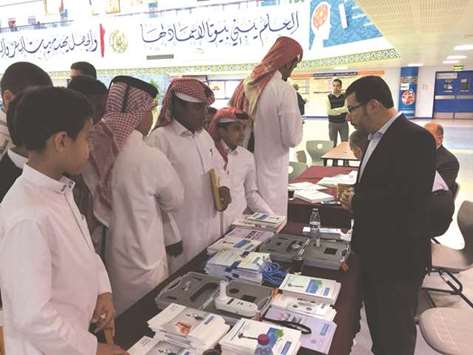Hamad Medical Corporation (HMC) has announced that its Tobacco Control Centre has launched an anti-smoking campaign in local schools.
This comes as part of the efforts undertaken to discourage young people from taking up the habit of tobacco use in Qatar, HMC has said in a statement.
Recently, students at Khalifa Independent Secondary School for Boys participated in an awareness seminar that covered the physical and psychological damage caused by tobacco use.
Staff from HMC provided students with educational materials and answered questions as part of the awareness event. Students also participated in an activity to measure the level of carbon monoxide in their system after learning how smoking tobacco increases the level of carbon monoxide in the blood.
Smokers, or people exposed to second-hand smoke from tobacco products, have increased levels of carbon monoxide in the blood which can lead to shortness of breath and an increased heart rate, along with numerous other diseases and health conditions.
Dr Ahmad al-Mulla, head of the HMC Tobacco Control Centre, said HMC also hosted an awareness exhibition at Ali Bin Abi Taleb Preparatory School for Boys on March 1 as part of HMC’s outreach programme to educate the community about the dangers of tobacco use.
During the exhibition, staff distributed educational materials, measured the level of carbon monoxide in the system of visitors, and answered questions about the dangers of smoking.
“When a person smokes a cigarette, poisons from the tar enter the blood and negatively impact their health, for example by raising their blood pressure and heart rate. Smoking can cause narrowing of the arteries, coronary heart disease, and stomach and lung cancer. Smoking can also severely affect the digestive system, contributing to problems like acid reflux, heartburn and peptic ulcers. It can lead to higher blood sugar levels, chronic headaches, insomnia and kidney damage. All of this is in addition to the negative psychological effects, including increased anxiety and tension,” Dr al-Mulla explained.
He said the school awareness campaign uses evidence-based strategies to educate students on the negative health consequences of tobacco use. He added that many of the Tobacco Control Centre’s community outreach programmes target young people, as statistics indicate at least 11% of smokers in Qatar are school students.
He stressed that the school campaign aims to prevent those who don’t smoke from picking up the habit, while also helping teens who do smoke, to stop.
Dr Jamal Abdullah, a smoking cessation specialist at HMC, also participated in the exhibition and said the use of carbon monoxide monitoring to demonstrate the immediate and potentially harmful consequences of smoking is an effective mechanism in helping young people understand how dangerous tobacco use is.
Dr Ashour Hussein, clinical psychologist at HMC’s Tobacco Control Centre, said peer pressure is one of the most widespread causes cited by young people when asked why they started smoking. He said other factors that contribute to young people picking up the habit include one or both of their parents smoking, stress relief and curiosity.
Dr Hussein concluded that smoking is one of the most dangerous, widespread phenomena threatening the health of young people in Qatar.

The anti-smoking campaign in local schools.
